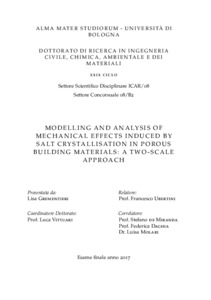Grementieri, Lisa
(2017)
Modelling and Analysis od Mechanical Effects Induced by Salt Crystallisation in Porous Building Materials: a Two-Scale Approach, [Dissertation thesis], Alma Mater Studiorum Università di Bologna.
Dottorato di ricerca in
Ingegneria civile, chimica, ambientale e dei materiali, 29 Ciclo. DOI 10.6092/unibo/amsdottorato/8002.
Documenti full-text disponibili:
![[img]](http://amsdottorato.unibo.it/8002/1.hassmallThumbnailVersion/grementieri_lisa_tesi.pdf)  Anteprima |
|
Documento PDF (English)
- Richiede un lettore di PDF come Xpdf o Adobe Acrobat Reader
Disponibile con Licenza: Salvo eventuali più ampie autorizzazioni dell'autore, la tesi può essere liberamente consultata e può essere effettuato il salvataggio e la stampa di una copia per fini strettamente personali di studio, di ricerca e di insegnamento, con espresso divieto di qualunque utilizzo direttamente o indirettamente commerciale. Ogni altro diritto sul materiale è riservato.
Download (23MB)
| Anteprima
|
Abstract
Salt crystallisation can induce high stresses in the microstructure of building materials constituting historic buildings and monuments.
This dissertation combines numerical methods at different scales to model and analyse the mechanical effects induced by salt crystallisation in porous building materials.
Two different scales are considered: the macro-scale, in which the porous building material is seen as a homogeneous continuum, and the micro-scale, being the scale in which can be distinguished the material matrix and the pores.
Regarding the macro-scale, a new Hygro-Thermo-Chemical (HTC) model is presented. The HTC model presented is specialised for sodium sulphate solutions and sodium chloride solutions.
Moreover, an enriched version of the HTC model is presented in order to describe different drying kinetics, taking into account the kind of efflorescence formation.
The HTC modelling results show a good agreement with the experimental data, proving the effectiveness of the proposed model.
Concerning the micro-scale, a micro-mechanical model is developed on the base of the real 3D micro geometry of a porous material, coming from X-ray Micro Computed Tomography
images. Some hypotheses on the loading condition of the micro-mechanical model, accounting for different crystallisation physics, are introduced.
It is shown that the micro-mechanical loading scheme adopted influences the macro-scale mechanical effects and that some approaches commonly used in the literature for their evaluation can lead to their underestimation.
In order to establish a link between the micro and the macro scales, a multi-scale approach, based on numerical homogenisation, is presented. It allows to predict the effects of salt crystallisation occurring at the scale of the structure.
Finally, the results of the proposed approach are incorporated in a Hygro-Thermo-Chemo-Mechanical model, which combines hygro-thermo-chemical aspects and the mechanical ones, to perform a structural computation with environmental and mechanical loadings to forecast the most probable damage scenarios.
Abstract
Salt crystallisation can induce high stresses in the microstructure of building materials constituting historic buildings and monuments.
This dissertation combines numerical methods at different scales to model and analyse the mechanical effects induced by salt crystallisation in porous building materials.
Two different scales are considered: the macro-scale, in which the porous building material is seen as a homogeneous continuum, and the micro-scale, being the scale in which can be distinguished the material matrix and the pores.
Regarding the macro-scale, a new Hygro-Thermo-Chemical (HTC) model is presented. The HTC model presented is specialised for sodium sulphate solutions and sodium chloride solutions.
Moreover, an enriched version of the HTC model is presented in order to describe different drying kinetics, taking into account the kind of efflorescence formation.
The HTC modelling results show a good agreement with the experimental data, proving the effectiveness of the proposed model.
Concerning the micro-scale, a micro-mechanical model is developed on the base of the real 3D micro geometry of a porous material, coming from X-ray Micro Computed Tomography
images. Some hypotheses on the loading condition of the micro-mechanical model, accounting for different crystallisation physics, are introduced.
It is shown that the micro-mechanical loading scheme adopted influences the macro-scale mechanical effects and that some approaches commonly used in the literature for their evaluation can lead to their underestimation.
In order to establish a link between the micro and the macro scales, a multi-scale approach, based on numerical homogenisation, is presented. It allows to predict the effects of salt crystallisation occurring at the scale of the structure.
Finally, the results of the proposed approach are incorporated in a Hygro-Thermo-Chemo-Mechanical model, which combines hygro-thermo-chemical aspects and the mechanical ones, to perform a structural computation with environmental and mechanical loadings to forecast the most probable damage scenarios.
Tipologia del documento
Tesi di dottorato
Autore
Grementieri, Lisa
Supervisore
Co-supervisore
Dottorato di ricerca
Ciclo
29
Coordinatore
Settore disciplinare
Settore concorsuale
Parole chiave
Finite element modelling, Mechanical effects, Salt crystallisation, Porous building material, Multi-scale approach, Homogenisation, Chlorides, Sulfates, Hygro-thermo-chemical model, Hygro-thermo-chemo-mechanical model, Micro-mechanical model
URN:NBN
DOI
10.6092/unibo/amsdottorato/8002
Data di discussione
18 Maggio 2017
URI
Altri metadati
Tipologia del documento
Tesi di dottorato
Autore
Grementieri, Lisa
Supervisore
Co-supervisore
Dottorato di ricerca
Ciclo
29
Coordinatore
Settore disciplinare
Settore concorsuale
Parole chiave
Finite element modelling, Mechanical effects, Salt crystallisation, Porous building material, Multi-scale approach, Homogenisation, Chlorides, Sulfates, Hygro-thermo-chemical model, Hygro-thermo-chemo-mechanical model, Micro-mechanical model
URN:NBN
DOI
10.6092/unibo/amsdottorato/8002
Data di discussione
18 Maggio 2017
URI
Statistica sui download
Gestione del documento:


 Login
Login
